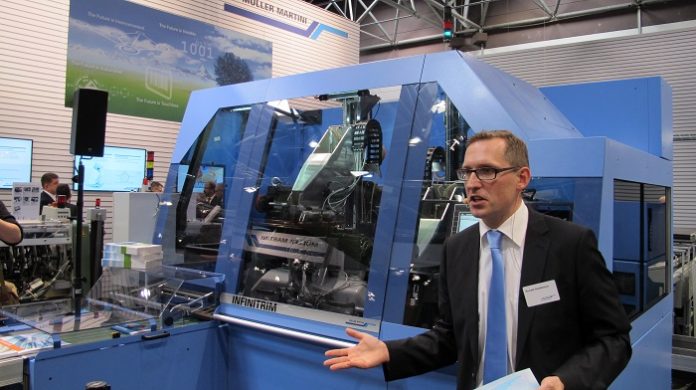
Müller Martini has developed a Switch Configurator that brings the power of Enfocus Switch to the Connex LineControl for SigmaLine process management solution. This integration combines the powerful prepress capabilities of Switch, with the book production expertise of Müller Martini to create an integrated, automated system that eliminates manual touches and streamlines the entire book production process – from the PDF all the way through to the final product. Live demonstrations of the new Configurator were shown at the Müller Martini stand at drupa 2016.
Müller Martini’s product manager for Connex, Andreas Aplien, says, “More and more, book printers are producing shorter runs – sometimes just one copy. To succeed in this new paradigm, it is critical for printers to control and automate their production processes. Adding the Switch Configurator to our solution makes this level of automation possible, giving printers the technology they need to profitably produce small volumes of books.”
Müller Martini’s Connex LineControl for SigmaLine supports book printers with several key functions, including job management for print finishing and printing press; imposition of PDF data based on the options and requirements of print finishing; control of the connected printing presses from speed through to the definition of the run size; automatic reprinting of an ejected product during production without manual intervention; automatic switching of the SigmaLine from format to format without manual intervention; and production of variable data via PDF/VT right down to runs of one copy.
To build on the strength of this solution, Müller Martini created a new Configurator that uses Switch to capture prepress data and uses that data as part of the workflow. The Configurator allows a user to set up production flows for specified products by creating a job setup file for the Connex LineControl. This job setup file is imported to the Connex LineControl which does the imposition, the press and postpress presetting and automatically starts the production of products.
The six Muller Martinis saddle stitchers and perfect binders and trimming systems running at its stand at drupa were connected to a Hunkeler production waste system to completely evacuate the cut-off, trimmed waste and dust generated. The production waste system worked on the basis of a negative air pressure within metal ducts that collected and pulled the waste from binders and trimmers to create compact bales for efficient transport. The Hunkeler waste collection and compaction systems including the BP baling system were also shown at the Hunkeler paper finishing stand and at the Canon, HP, Gietz and Leonard Kurz stands.
For instance, Muller Martini demonstrated its intelligent variable perfect binding systems that can consecutively collate and bind books of varying thickness or pages and size. Connected to it was a Hunkeler waste disposal system demonstrating that it could intelligently vary the negative pressure to evacuate waste strips and cuttings with huge differences in size and hence weight. Equipped with intelligent energy saving and automatic switch off systems the only active when needed equipments allow an energy savings of 40%.
At the Leonhard Kurz stand, Hunkeler Systems presented its new HKU 2000-v compact disposal system with a special continuous compression feature that can run without a stop during the entire production process. An endless plastic bag is sealed and separated into economical transport sizes and this method leads to a completely clean change over and disposal for substrates including labels, holograms and paper.
The intelligent waste gathering, baling and disposal packaging systems are especially useful for the the production and secure waste disposal of security documents and bank notes. For bank notes, a newly designed shredding system with a knife lifetime that has been increased four time over existing models has been developed. In addition, for the secure supervision and reporting of the full destroying process, the Hunkeler waste disposal systems use finger print log-in identification while the workflow management system compares total material inputs and outflow and the software flags all error and status messages.















